
Dock of the Bay

Volume VI Number 30
July 30 - August 5, 1998
Can Genetic Engineering Conquer Rabid Raccoons?
In Texas, it's coyotes. In Ontario, foxes. Here
in Maryland, as residents of Huntingtown in Calvert County recently were
reminded, it's raccoons -- rabid raccoons.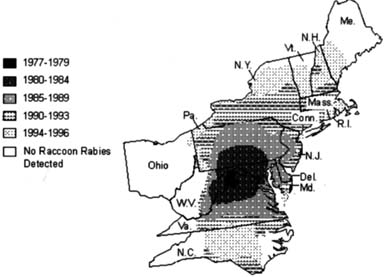
Around the country, rabies in wildlife is on the rise. Over three decades, the number of cases reported in wild animals yearly has doubled in the United States: from 5,000 in the early 1960s to over 10,000 today. Last year, 33 people in Anne Arundel County were treated for possible exposure to rabies. So far this year, at least 38 people have received treatment.
Here at home, health officials hope to do something about those numbers -- or at least our share of them. In a joint project with the Maryland Department of Health and Mental Hygiene and the Society for the Prevention of Cruelty to Animals the Anne Arundel County Health Department announced plans last week to combat rabies in wild raccoons on the Annapolis Peninsula using a new oral rabies vaccine.
Raccoon rabies has been a growing problem in Anne Arundel County since the disease first swept across Maryland in the early 1980s. Last year, Anne Arundel County led the state in the number of animal rabies cases: 97. Most were wild raccoons. Annapolis Neck accounted for almost a third of the cases, said Dr. Joseph Horman, the county health department's senior epidemiologist, who is also leading the project.
Geography is another reason to target the Annapolis area. The Severn and South rivers - not to mention the Bay - are natural barriers that help to keep non-immunized raccoons off the 33-square mile peninsula.
Rabies will be combatted rabies by immunizing raccoons, which is no easy job. The task will use bait impregnated with the new genetically engineered oral rabies vaccine, Raboral V-RG. The bait, made of raccoon-rousing fish meal and fish oil, contains a plastic packet of liquid Raboral V-RG. When the raccoon bites into the bait, the packet pops, releasing the liquid vaccine into the animal's mouth.
In the Annapolis project, 9,000 of the small, brick-shaped oral vaccine baits will be placed by hand or dropped by helicopter over 21,270 square acres during the last two weeks of October.
Raboral V-RG was licensed last year by the U.S. Department of Agriculture after 10 years of successful field trials. Unlike vaccines made from weakened rabies virus, Raboral V-RG can't cause rabies, since it contains only portions of the virus' genetic material.
Rabies is caused by a virus that attacks the central nervous system. Because the virus is found in saliva, wild animals can readily transmit the disease among themselves when interacting with mates or young. For humans, the greatest threat comes from bites from an infected animal. Without treatment, rabies is fatal.
The cost of fighting rabies is staggering: $230 million to $1 billion per year, according to the Centers for Disease Control. Recently, in New Hampshire, a single rabid kitten caused 665 people to undergo treatment at a cost of $1.5 million dollars.
Closer to home, 12 Calvert and Charles county residents recently received rabies shots after being exposed to a dog that had tangled with a rabid raccoon in Huntingtown they joined the more 22,000 people in the U.S. who receive the post-exposure treatment each year.
On the average, treatments cost $1,500 per person. In comparison, each oral vaccine bait costs $1.52.
How did this raccoon rabies mess get started?
Raccoon rabies set out from central Florida in the late 1940s, advancing northward to infect the southeastern United States: Georgia, Alabama, South Carolina.
The rabies epidemic - or epizootic, to be precise - scourged its way through the Mid-Atlantic raccoon population, spreading at a rate of 40 miles per year. In 1977, raccoons, imported to enhance hunting stock, brought rabies to Maryland.
By 1996, raccoon rabies reigned over most of the Northeast: from Maine to North Carolina, from the Atlantic coast to the Great Lakes and Ohio River Valley. Today, the region accounts for 75 percent of the nation's rabid raccoons - which is why vaccine-laden baits are dropping over Vermont, Massachusetts, New York, New Jersey and Ohio.
And soon Maryland.
Aside from a similar effort in the works in Frederick County, the Anne Arundel rabies vaccination project is unique in the state. "There's no state-wide oral bait program yet, due to logistical and funding problems," said Dr. Clifford Johnson of the Maryland Department of Health and Mental Hygiene's Center for Veterinary Public Health. So we'll have to help ourselves.
To do so, keep these facts in mind:
-Don Kehne
At St. Mary's, Peeling Back the Skin of Time
Scraped from the bottom of the pit, the coffee-colored dirt is lumped in the middle of the screen. A dozen hands reach in but stop with a gentle admonishment from the pith-helmeted leader.
"Now wait a minute, let me shake it and we'll see what we can find." As the fine dirt falls to the ground, clods in white and brown rattle on the sieve.
"What's this white stuff?"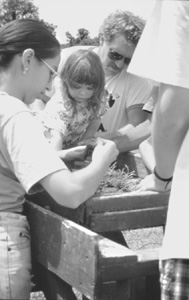
"Oh, probably a bit of animal bone," she replies patiently. "But this is a nice piece of pottery shard, and this is a bit of brick. Let's make sure we put them in the right bag."
Archaeology students at St. Mary's College are peeling back the skin of time in a small grove of trees overlooking the St. Mary's River. They are piecing together a mosaic of bricks and pottery and, yes, maybe bone, to unravel the mystery of a Colonial city that has been buried and lost for almost 300 years.
I took advantage of an archaeology open-house hosted by the students of this summer's field school. Most are from St. Mary's College, but many come from all over the country.
"These students are in the middle of a 10-week session, learning archaeology principles. This is their sixth week, and we figure they know enough by now to tell other people what is going on here," says Timothy Riordan, historical archaeologist and field school supervisor.
The site is considered by many the most significant Colonial site in America, both in historical importance and the relatively undisturbed conditions of the artifacts. Despite all this technical jargon, my daughters and I managed to have an enjoyable day. Their verdict, as we drove home? "It's cool," they volunteered.
Historic St. Mary's City, as it is officially called, is an outdoor history museum and archaeological park. Combining impressive academic research with fun-loving costumed guides and well-constructed and detailed displays, the park offers a step back into a relatively unknown period of American history. From 1634 to 1704, St. Mary's was Maryland's first capital. In this long-forgotten spot were many of America's firsts:
I was last here in 1981, when the only building was the reconstructed
State House and the replica of the trading ship the Dove. It was hoped that
nearby corn fields could be bought from a farmer because there was an old
legend of a beautiful chapel and graveyard and houses that might be found
there.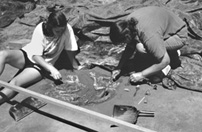
The legend was true. The introductory video in the Visitor Center, narrated by Walter Cronkite, shows not only the discovery of the 1667 Chapel but also the investigation and identification of the three lead coffins that were found under the floor. The coffins themselves, and other well-done displays, are next door.
When I now walk into the past, there are no jangling buses or microphoned guides. We walk on a path of mown grass, birds fluttering above and crickets chirping and bees buzzing. The path makes an easy loop, including a Woodland Indian Hamlet, Chapel site, Town Center site, Farthings' Ordinary and Kitchen, the reconstructed State House and the replica of the Dove. The path follows, for the most part, the original town road. "Ghost buildings" of wood framework mark the places of known sites, to be excavated in the future. A few buildings have been constructed to give an idea of size.
At all the spots are guides so totally immersed in the life of that time that I hesitate to call them costumed. The Yaocomico at the Woodland Hamlet, who met us and demonstrated how the Indians helped the first settlers, wore only a deer skin, nicely embroidered, over his hips. He was so informative, the only question my daughters whispered to me as we left was, "Did the Indians wear underwear?"
I learned how the early settlers coped with teenagers at our stop at the Farthing's Ordinary, or Inn. The proprietess informed me, shaking her head in disapproval, that I had "a couple of years left with the 10-year old, but ye should have that 13-year old married by now. I know a nice widower whose wife died in childbirth and he be looking for a new one."
At the Plantation down the road, Godiah Spray was delighted to see the "new milk maids." Although thrilled with the thought of milking the cows and feeding the pigs, my daughters' enthusiasm waned when informed of the rest of their job description; "feed the chickens, mend the clothes, grind the corn, weed the garden, fetch the water "
Back at the archaeological site, I am impressed. Squares about five feet each side are interspersed under the trees. Students are quietly explaining to clumps of people as others take a turn at the sieves. They are looking for the print shop, which might be here because in test diggings they found some lead type. Inside the Dig Tent are meticulous architectural models of the Chapel, to be reconstructed using the original methods.
I am struck by one square. Inside are two brick patterns, in each corner. One is a bit of a jumble; the other are bricks placed in a careful pattern. The student happily informs me that they believe one corner is from the slave quarters from the 19th century farm, while the other appears to be from the 17th century. Maybe they found what they are looking for, and another piece of the puzzle is laid.
Historic St. Mary's City Living History Museum is open Wednesday thru Sunday, 10am to 5pm. The season is from March 16 to November 29. Find it on Route 5, adjacent to St. Mary's College: 600/SMC-1634
-Aloysia C. Hamalainen
Junkers, Clunkers and Sunkers Raise Big Bucks for Charity
You're tired of looking out of your window at that old junker. Your driveway is beginning to look like a used car lot.
And that old boat and RV? You don't even want to think about them.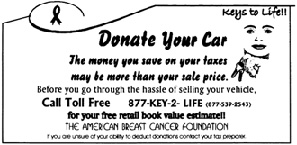
What to do? Trade it in? Sell it? Sounds like another hassle.
You have another alternative, one that lets you have your cake and eat it too. You can get Blue Book value on your car, truck, motorcycle, boat or RV by donating to charity.
"I donated my car to the American Cancer Society for two reasons," said Dottie Depfer of Glen Burnie. "One, because I wanted to help people who have cancer and two, because I couldn't get Blue Book value for it anywhere else."
Depfer's 1989 Ford Probe brought her nearly $5,000 in tax write-offs.
Along with the always treasured tax break, you are able to dismiss that unwanted vehicle virtually hassle free.
"This is an excellent alternative for people who have cars they don't want to sell," explains Patricia Prouty of the American Cancer Society. "It's simple, very fast and there is no charge to the donor whatsoever. At the same time, they're doing some good by donating for a good cause."
Fund-raising methods have to keep up with lifestyles. The American Cancer Society's beauty contest, Miss Hope Pageant, ended two years ago, replaced by such for-our-time fundraisers as golf tournaments and races, including Relay for Life and Stride for Life. In a world where everybody's got a couple cars and maybe a boat or RV, what could better hook people in their self-interest than a way to get rid of the old ones?
The Salvation Army takes credit for pioneering vehicle donations as a source for funds. In Baltimore, such donations help the Salvation Army fund their Adult Rehabilitation Center, which provides a long-term residential program for men seeking recovery from substance abuse.
"Since early on, we were one of the charities utilizing this fund-raising opportunity," says Captain Don Smith, administrator of the Adult Rehabilitation Center, where vehicle donations have been accepted throughout the '90s. "This is a convenient and comfortable way to make a donation."
The Chesapeake Wildlife Sanctuary, another veteran of raising funds with
vehicle donations, is a shock trauma hospital for injured and orphaned animal
wildlife. Executive Director Margerie Hewitt says they've been accepting
vehicle donations for at least five years now to help buy medications and
food for the animals.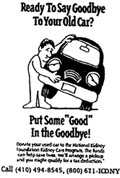
Other organizations are also finding profit in brokering unwanted vehicles.
Summit School in Edgewater, a school for children with learning disabilities, has been using this tactic successfully since November of last year. "Profits can be pretty significant for us," said development director Ginny Joy, who credits donations with raising close to $20,000. Vehicles donated to Summit School are auctioned off and the proceeds used to pay off the debt for the new school building.
Most charities auction off vehicles donated to them. Once a donor calls and gives information on a vehicle, the charity arranges to have it towed to a local auction. The exchange is complete once the title is signed over. The vehicle is then sold at auction.
Proceeds are used in a number of ways depending on the organization. The American Breast Cancer Foundation, Maryland Chapter, provides free mammograms to women who cannot afford to pay for the examination. The foundation has been on the vehicle donation bandwagon for about five months. "We're raising money right now to purchase a portable mammogram site van," said Steve Sellers, project coordinator for the American Breast Cancer Foundation. Contributions are occasionally traded for other materials needed.
Will your old vehicle make the cut? Most organizations will accept any vehicle of any value, but there are some exceptions. The Salvation Army, for example, does not accept donations of campers. Nearly all organizations ask that tires be inflated so vehicles can be towed.
All the organizations will take your old boat off your hand - with some strings. The American Cancer Society accepts only newer boats, but does not require boat trailers if donated in Maryland. Other charities, such as American Breast Cancer Foundation and Chesapeake Wildlife Sanctuary, require trailers to accompany boats. Instead of towing to the auction, Summit School will have its auctioneer take photos of any vessel more than 25 feet in length.
So if you want to downsize your used car lot or kiss your old boat good-bye, call a local charity.
For Blue Book information on your car, you can visit Kelley Blue Book at www.kbb.com.
For Blue Book information on your boat, you can purchase ABOS Marine Blue Book by calling Intertec Publishing: 800/262-1954.
-Darcey Dodd
Editor's note: This is intern Dodd's first story for NBT.
"Down East" Where Maryland Clams Go To Be Loved
photo by Marion Warren
Clambakes, fried clams and clam chowder. Soft-shell
steamers and hard-shelled quahogs.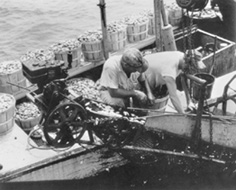
Clams are to New Englanders like crabs to Marylanders: Few foods are more satisfying to summer appetites.
But after record spring rains in Maine, clams are scarce and many shellfish beds closed. Run-off carried pollution into harvesting grounds all over the north coast.
But demand didn't ebb, sending wholesalers in search of clams. They've found them in Canada, albeit with sand and gravel. Where many are coming from might be a surprise to New Englanders and Marylanders alike: Chesapeake Bay.
Attitudes toward clams differ as you head north. Marylanders haven't developed much of a taste for the soft-shelled clam even as coastal communities invest heavily to reseed mud flats and reverse a long decline in their clam population.
In fact, Maryland ships 90 percent of its annual clam harvest to markets from New York to Maine, according to Noreen Eberly, spokeswoman for the Maryland Department of Agriculture's Seafood Marketing Program.
Maryland watermen are likely to raise 25,000 bushels of soft-shell clams out of the soft bottom of the Bay, raising clouds of sediment as they reap. That's a lot, but a lot fewer than with 10 or 15 years ago, according to Pete Jensen, deputy director of Fisheries Service at Maryland's DNR. Catches were much bigger in '94 and '95, too: 37,000 bushels in both years.
But for now, Maryland harvests still satisfy the appetites of clam lovers in coastal areas of Maine and Massachusetts, an area known locally as "Down East."
Marylanders aren't likely to give up their crabs for clams any time soon. If they do, expect the clam wars to begin.
-M.L. Faunce w/Kim Cammarata
In Carderock, the Naval Surface Warfare Center has developed a processor that can reduce six 30-gallon bags of plastic waste into one small disk. Good thing, because Congress has ordered the Navy to install plastic processors on 200 of its ships by year's end ...
Philadelphia journalists concluded that millions of migratory songbirds die each year smashing into the 75,000 communications towers in the U.S. According to the Philadelphia Inquirer, birds traveling at night using stars to navigate become disoriented at the towers' flashing red lights. The towers are here to stay, so researchers are exploring using microwaves to drive the birds away...
In Arizona, sprawl is threatening the 22,000-acre San Rafael Ranch, where the movie Oklahoma was filmed. But state officials are stepping in to pay the property owners not to subdivide, the Arizona Republic reports ...
Our Land Trust of the Week comes from northern California, where the Nature Conservancy is spending $19 million to buy two ranches whose acreage is twice the size of San Francisco, the San Jose Mercury News reports. The ranches total 61,000 acres. The one owned by Wells Fargo & Co. Cattle will remain, and the public will be allowed to roam around ...
In Cuba, President Fidel Castro is looking green in more ways than his fatigues. Last week, Castro announced a new reforestation to plant the island in light of new statistics showing that just 13.5 percent of its trees remain ...
Our Creature Feature this week is a double feature about skunks. And what better place than a drive-in movie theater to begin. The Star Auto Theater in Wauseon, Ohio is under siege by skunks drawn by French fries and snacks. The upshot, literally, is not conducive to amorous behavior by movie-goers in the back seat. "They let go their foul-smelling liquid and the smell drifts through the whole place," said theater owner Robert Wyse.
Meanwhile, Creature Feature brings you an update on the skunks running around with Yoplait yogurt cartons stuck on their noses. General Mills, the company that makes Yoplait, last week announced a new "animal safe" container with a wider mouth. Said General Mills' spokesman Jack Sheehan: "A dozen dead skunks is a dozen dead skunks too many."
| Back to Archives |
Volume VI Number 30
July 30 - August 5, 1998
New Bay Times
| Homepage |